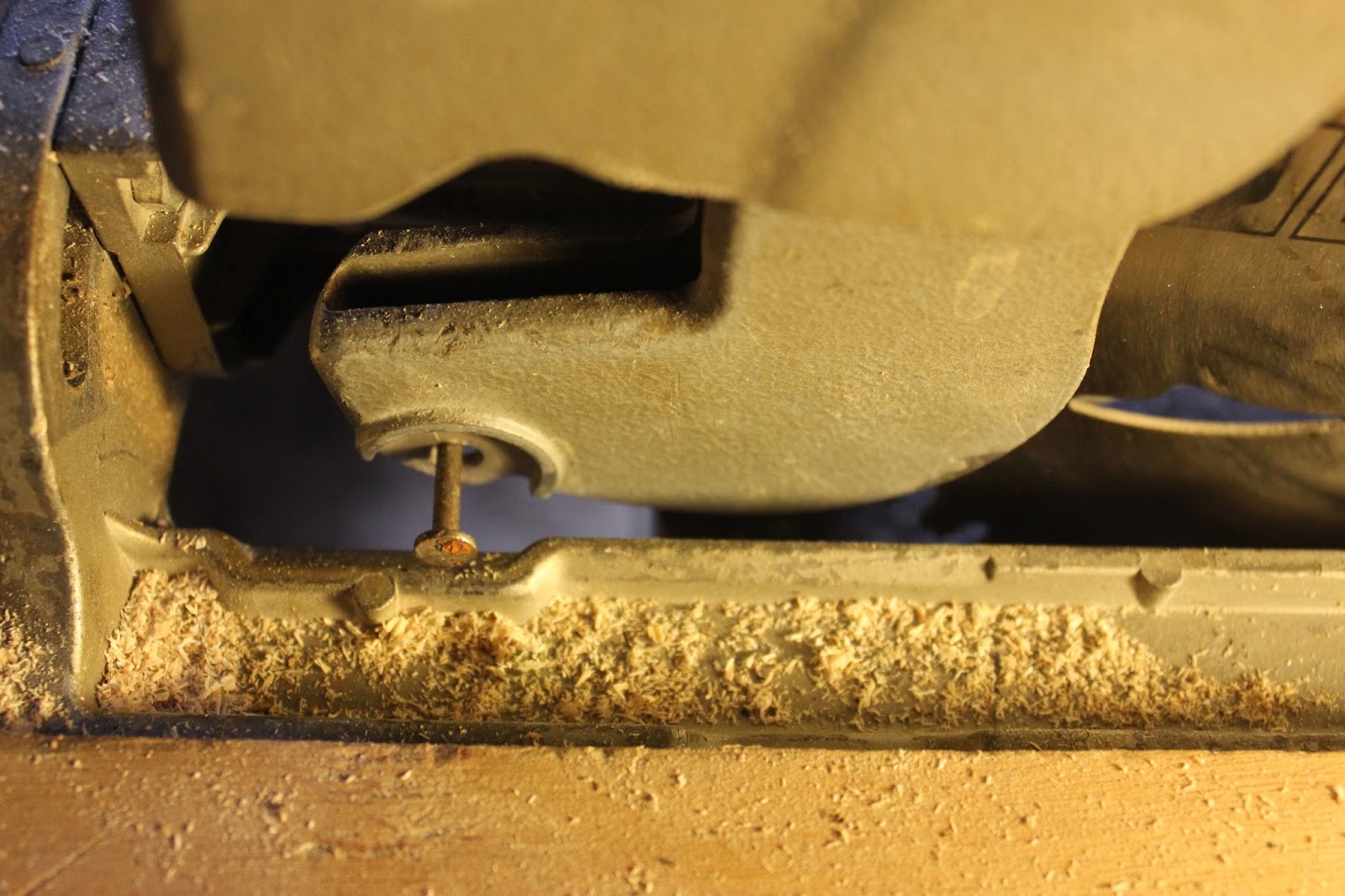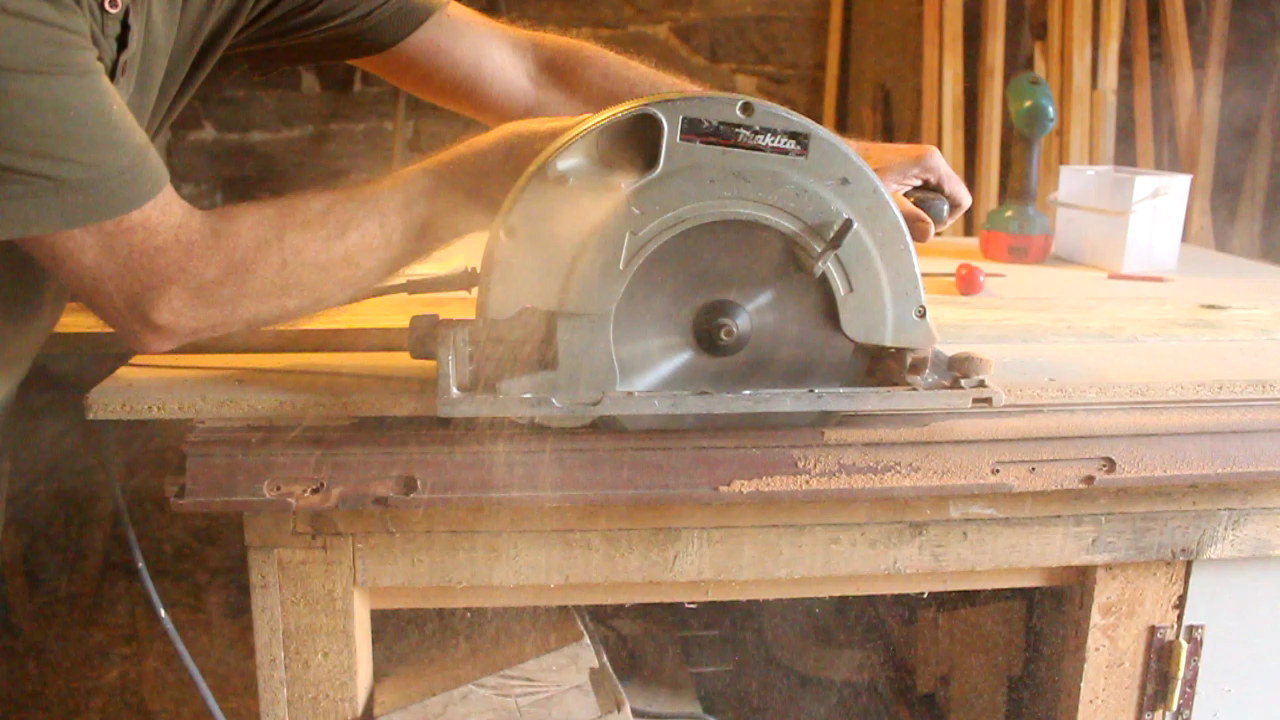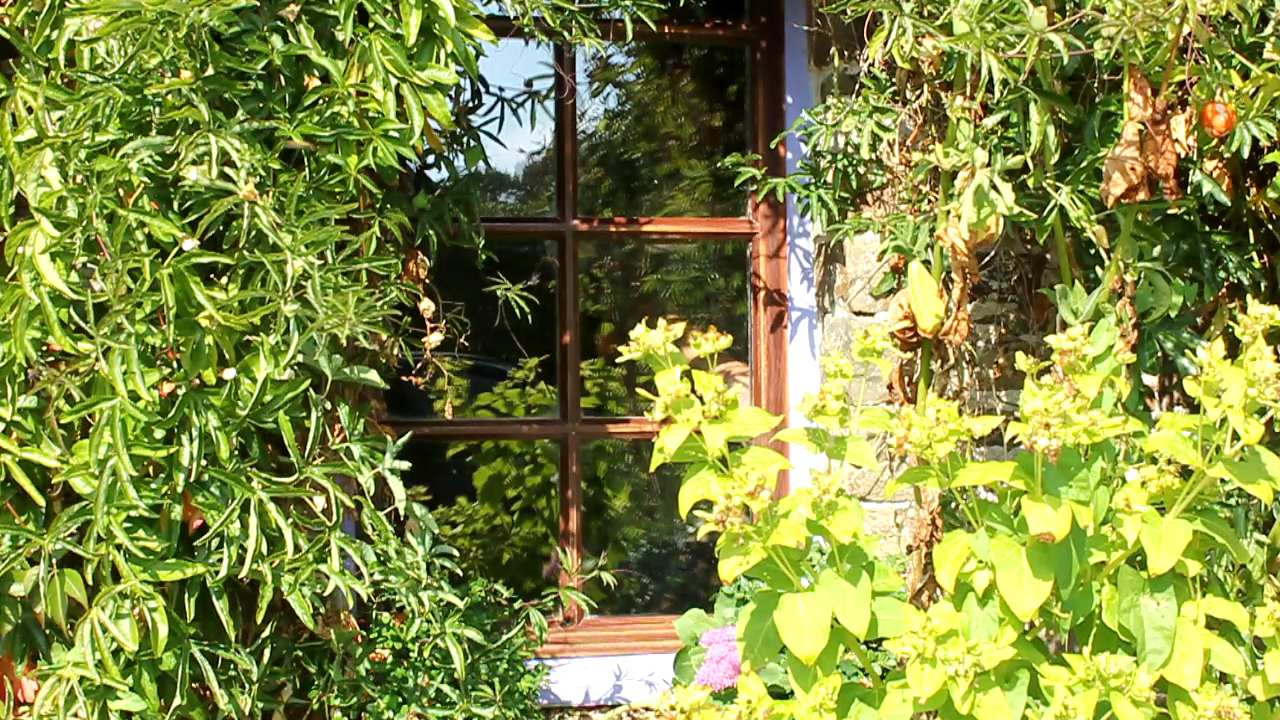On one of my regular visits for pallet collection, one of my ‘suppliers’ had thrown out a steel-framed transport dolly with small castor wheels welded to it. This was transported home with the pallets as I realised the castors were the essential final part in the plan I had to onstruct a crosscut saw table.
Overview
I wanted the portable circular saw to fit onto some kind of sliding table, the exposed saw blade would be beneath the table and would cut stuff held in the blade’s path.
Thus the castor wheels would be screwed upside down to a baseboard and the table holding the saw would run on the castors. The table’s movement would be restricted to a forward/backward motion by guides or tracks on the underside of the table into which the castors would fit.
I needed to remove a little more wood from the hole edges with a rasp to obtain the snug fit of the saw’s base in the hole.>
On the underside of the table I attached four lengths of wood for the guide rails. The position of the ‘inboard’ guide rails were such that about 6mm (¼”) of the guides longest edge extended over the hole edge so as to be the support for the saw base.
To ensure that the rails were correctly aligned, I used the cut-out of plywood as a guide. I affixed a straight edge to the rectangle such that the inboard guide rails' edge would butt up to it, this produced the 6mm overlap of the hole's edge.
Once the first inboard guide rail was glued and screwed in place, the plywood cut-out was turned around to furnish the guide for the second inboard rail. The other two guide rails were attached a castor wheels width from the ‘inboard’ guide rails.
The castors were of the swivel type so once removed from the dolly frame I separated the castor wheel and frame from the castor base by sawing through the swivel pin.
had selected a table base from a pallet top made of MDF which I had checked for flatness.
I knew the distance the castor wheels needed tobe apart (this being the guide width on the moving table) and screwed the first pair of wheels near to the edge of the MDF base.
The other two wheels were screwed in line with the first pair of castors at a distance slightly less than half the length of the moving table.
Once I had checked that the tracks on the underside of the moving table engaged correctly with the castors and would move to and fro with ease, I screwed stops on the front and rear edges of the moving table to prevent 'derailment'.
The final stage was to attach a guide edge at right angles to the saws' direction of travel.
This was attached to the MDF base. I made a slotted hole at one end of this guide and clamped it to the base with a wing nut so as to provide a small amount of adjustment.>
When I need to use the crosscut saw table, I firstly clamp the base to a 'Workmate' or workbenchThe moving table is placed onto the castors and the saw baseplate is pushed into the rectangular hole at the same time holding the blade guard in the 'open' position (blade exposed).
Once seated in position the guard is held open by putting a nail through a hole in the guard perimeter and letting the nail rest on the top face of the saw baseplate. Next, the saw blade cutting height is adjusted so that the blade touches the MDF table surface and then it is locked at this cutting depth.

To cut the timber the saw is drawn back away from the guide, the timber is slid into place and held firmly against the guide edge. If I only need to cut one or two pieces of wood I mark the desired cutting point with a pencil and can see this mark through the hole in the baseplate (see image above)The stationary blade may then be brought up to the wood edge to ensure exact positioning with the mark. Moving the saw away from the edge prior to starting prevents 'snatch' .
 If a greater number of equal length pieces are required I find it easier to clamp an end stop to the baseboard against which the edge of the timber can be held.
If a greater number of equal length pieces are required I find it easier to clamp an end stop to the baseboard against which the edge of the timber can be held.
The recuperated castors allow for a timber thickness of 50mm (2"). This I have found to fulfil my current needs but the saw is able to cut to a depth of 85mm (3¼"). To attain this one could use larger castors or raise the small castors on blocks.
Now, if you'd like to, sit back and watch the film:
If you've enjoyed this article and found it useful please feel free to share it or to comment and/or make observations. All the very best and until next time,
Andy © Andy Colley 2015
RETURN TO GREEN LEVER CONTENTS PAGE FOR MORE ARTICLES
Method
The first stage was to make the moving table into which the saw’s base would fit, using a rectangular piece of plywood recuperated from a pallet top. I positioned the saw centrally and traced the outline of the saw’s base upon it. The rectangular hole was cut with the circular saw guided by a straight edge clamped to the plywood. I used a pull saw to complete the saw cuts at the four corners.
I needed to remove a little more wood from the hole edges with a rasp to obtain the snug fit of the saw’s base in the hole.>
On the underside of the table I attached four lengths of wood for the guide rails. The position of the ‘inboard’ guide rails were such that about 6mm (¼”) of the guides longest edge extended over the hole edge so as to be the support for the saw base.
To ensure that the rails were correctly aligned, I used the cut-out of plywood as a guide. I affixed a straight edge to the rectangle such that the inboard guide rails' edge would butt up to it, this produced the 6mm overlap of the hole's edge.
Once the first inboard guide rail was glued and screwed in place, the plywood cut-out was turned around to furnish the guide for the second inboard rail. The other two guide rails were attached a castor wheels width from the ‘inboard’ guide rails.
The castors were of the swivel type so once removed from the dolly frame I separated the castor wheel and frame from the castor base by sawing through the swivel pin.
had selected a table base from a pallet top made of MDF which I had checked for flatness.
I knew the distance the castor wheels needed tobe apart (this being the guide width on the moving table) and screwed the first pair of wheels near to the edge of the MDF base.
The other two wheels were screwed in line with the first pair of castors at a distance slightly less than half the length of the moving table.
Once I had checked that the tracks on the underside of the moving table engaged correctly with the castors and would move to and fro with ease, I screwed stops on the front and rear edges of the moving table to prevent 'derailment'.
The final stage was to attach a guide edge at right angles to the saws' direction of travel.
This was attached to the MDF base. I made a slotted hole at one end of this guide and clamped it to the base with a wing nut so as to provide a small amount of adjustment.>
Operation
When I need to use the crosscut saw table, I firstly clamp the base to a 'Workmate' or workbenchThe moving table is placed onto the castors and the saw baseplate is pushed into the rectangular hole at the same time holding the blade guard in the 'open' position (blade exposed).
Once seated in position the guard is held open by putting a nail through a hole in the guard perimeter and letting the nail rest on the top face of the saw baseplate. Next, the saw blade cutting height is adjusted so that the blade touches the MDF table surface and then it is locked at this cutting depth.

To cut the timber the saw is drawn back away from the guide, the timber is slid into place and held firmly against the guide edge. If I only need to cut one or two pieces of wood I mark the desired cutting point with a pencil and can see this mark through the hole in the baseplate (see image above)The stationary blade may then be brought up to the wood edge to ensure exact positioning with the mark. Moving the saw away from the edge prior to starting prevents 'snatch' .
 If a greater number of equal length pieces are required I find it easier to clamp an end stop to the baseboard against which the edge of the timber can be held.
If a greater number of equal length pieces are required I find it easier to clamp an end stop to the baseboard against which the edge of the timber can be held.Improvements and modifications
I have definitely found the need for adding a small light over the table, specifically to illuminate through the hole in the saw baseplate so as to clearly observe the cutting marks.The recuperated castors allow for a timber thickness of 50mm (2"). This I have found to fulfil my current needs but the saw is able to cut to a depth of 85mm (3¼"). To attain this one could use larger castors or raise the small castors on blocks.
Conclusion
The home made crosscut saw table has proven to be a valuable addition to the workshop and has made a robust hand power tool into a precision cutting tool at little cost. Equally important is that it may be easily and quickly converted from one form to the other.Now, if you'd like to, sit back and watch the film:
If you've enjoyed this article and found it useful please feel free to share it or to comment and/or make observations. All the very best and until next time,
Andy © Andy Colley 2015
RETURN TO GREEN LEVER CONTENTS PAGE FOR MORE ARTICLES




































































